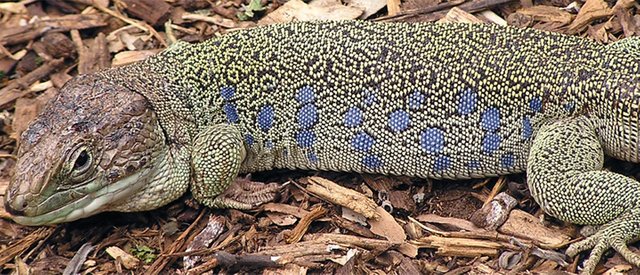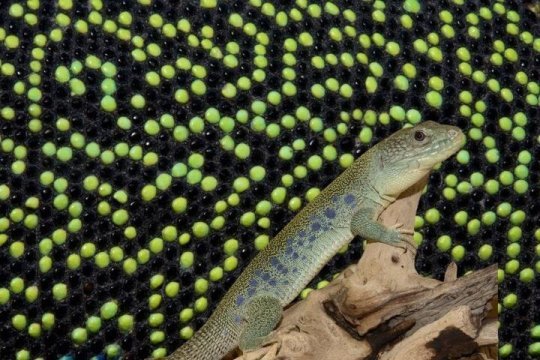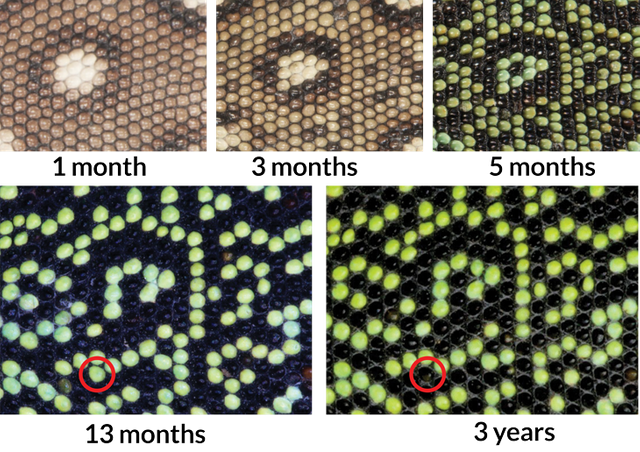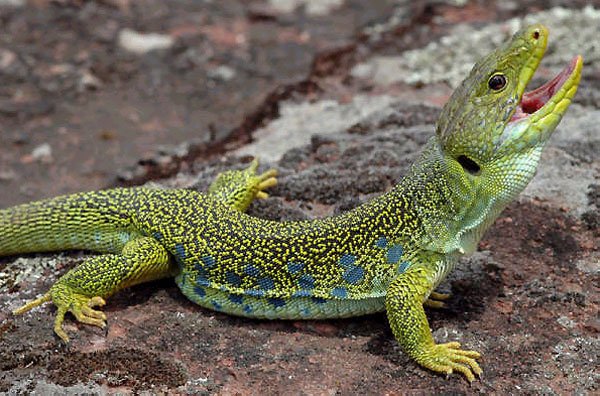A Lizard's Color Shifting Is Based in Mathematical Formulas (von Neumann and Turing)
Remember how your teachers always said that you needed an basic understanding of mathematics regardless of what profession you wanted to pursue as an adult? It's sound advice; from basic addition and subtraction to complex formulas and equations, you're going to be exposed to some form of math at some point (even if you don't completely realize it). Working with snakes and other reptiles, I'm expected to do my fair share of math; from using weight logs to map out animal nutrition to calculating the concentrations of medications to be administered, I am constantly checking and rechecking numbers to be sure our animals are kept in top condition. But a new study reveals that mathematics may play a greater role in herpetology; it seems as though some species of reptiles follow mathematical rules.

The colorful fellow pictured above is an ocellated lizard, a medium sized lizard native to Europe. Now these guys aren't born with their remarkable patterns and colors, they begin life a dull shade of brown speckled with white polka dots. It's as they mature and grow that this unimpressive pattern shifts towards a brilliant green and black labyrinthine work of art. Researchers studying this transformation are still not entirely sure why the lizard makes this colorful transition, but they may have stumbled upon how the change takes place: the scales appear to change based on a mathematical model. More bizarrely, this model is different than the one that scientists long believe dictated what patterns animals had.
One major theory suggesting how biological patterns form was brought to us by an unexpected source: codebreaker Alan Turing. That's right, Turing, the guy that invented computers, came up with a biological theory that has persisted for over half a century. 65 years ago, it was Turing who suggested that the huge variety of biological patterns, such as stripes and spots (and even appendages like tentacles and fingers) were the result of chemical reactions between two theoretical substances: an activator and an inhibitor. He hypothesized that these two substances spread out across an animals skin in different patches, and the varying interactions between them resulted in the many patterns seen in the animal kingdom. The video below briefly illustrates the process Turing hypothesized.
So we know that, while some patterns seem to deviate from the Turing mechanism, others seem to fall right in line with it. Today biologists, mathematicians and programmers are working together to figure out exactly what types of patterns abide by Turing's mechanism and uncover the identity of these so-called "activators and inhibitors".

Now, back to our ocellated lizard friend. An evolutionary biologist by the name of Michel Milinkovitch set out to explore whether or not Turing's model explained how the lizards could change the colors of their scales to their ornate pattern. What interested the biologist most was that these color patterns were formed at the level of scales (the scales are either entirely black or entirely green) and not at the level of biological cells, which would be more in line with the Turing mechanism (Source). Milinkovitch and his colleagues took periodic 3D scans of three ocellated lizards from the time of their birth up until about 3 years of age. What they discovered was that the scales didn't simply change and settle on a color, rather they would continuously flip from green to black and back to green; their patterns seemed to be in a constant state of flux. However, at any given moment, the color of each scale seemed dependent of the color of neighboring scales. Green scales were typically surrounded by four black and two green scales, and black scales were bordered by three black and three green scales (blue spots and ventral scales were excluded).

The patterning seemed to resemble a mathematical model developed by John von Neumann in the 1940's: the cellular automaton. To put it in simple terms, the cellular automaton is basically "a grid of connected units, and the state of each unit is governed by the state of its neighbors" (source). (To fully understand the concept, you can play with a famous automaton simulation here). So this observation begged an important question:
“What if each scale is changing color as a function of the state of its neighbor?” (Source)

After looking over their findings and crunching the numbers, Milinkovitch and his colleagues confirmed that the scales were behaving as von Neumann's automaton dictated.
“Each scale senses the color of its neighbors and then takes a decision on the basis of its neighborhood.” -Milinkovitch Source
Now the team has a new task at hand: it is still not known what biological signals or processes are dictating the autonomy of the cells.
So, was Turing's mechanism wrong when it comes to the ocellated lizard?
Actually, when the lab team adjusted their model to incorporate the thickness of each scale (and the thinness of skin connecting them), the Turing model suddenly seemed to work! Under the right conditions, the team's data suggests that Turing's mechanism could create a von Neumann cellular automaton...on the skin of an animal.
This study reveals that "a cellular automaton is not just an abstract concept, but corresponds to a process generated by biological evolution.”-Leah Edelstein -Keshet, mathematician at the University of British Columbia Source

When asked why the findings matter, Milinkovitch has an elegant response.
We just want to understand better the universe. And in this case, our universe is this beautiful lizard.” -Milinkovitch Source
Video Link: 1
Articles: https://www.sciencedaily.com/releases/2017/04/170412132330.htm
https://www.theverge.com/2017/4/16/15306962/ocella...

Fantastic post @herpetology guy. The ocellated lizard almost has a steem logo on it. I wonder what compounds the activators and inhibitors may be.
There's gotta be one out there somewhere with a steemit logo!
I haven't heard about those explanations before reading your post. Awesome job! That lizard's colors are so beautiful!
Great post..upvote.greets
Great informative post! However, not entirely surprising. There are other examples in nature in which math is envolved, like the fractal patterns in which some plants grow.
Btw., I also thought that lizzard in the first picture is showing the Steemit logo... :)
Amazing application of mathematics in nature. Is there a model for the camouflage of octopuses?
This is amazing and again God created everything so wonderful thank you for sharing I liked reading your posts.
waao! Just amazing concept of "Mathematics" subject found in a reptile. Never ever experienced such a wonderful idea from anyone till now. So, the final conclusion that can be drawn from this idea is that : " It might be we humans were evolved from reptiles too. May be we humans were more better ampbhibians than this lizard in the past. I mean humans might have capability of being both "terrestrial" and "aquatic" living beings on this planet. Who knows...??
Actually, we did evolve from reptiles (waaaaay way way back when). Mammals split off from reptiles millions of years before the dinosaurs so in a way, you could say he's a distant evolutionary cousin.
Could humans evolve to be aquatic? That's a tricky question. We aren't likely to evolve that sort of thing for a few reasons. 1. Most humans don't interact with the water enough that we would move towards an aquatic lifestyle, and 2. we don't face many of the pressures of natural selection that would drive evolutionary changes to that extreme. So I personally don't think it's likely that there will ever be aquatic humans unfortunately. BUT there are humans that do bear some aquatic adaptations. Free divers (those who can dive without the aid of dive equipment) can hold their breath far longer than most people, see reasonably well underwater, and tolerate greater water pressures. Who knows, maybe they will move towards a form with a greater affinity to water.
Exactly! That's what I wanted to hear from you about the rare case of human who can dive into the water and hold breadth for a longer time as compared to others. This shows that there is probability we can achieve this acqatic life as well along with the terrestrial life. But it will require lot of research to study about the features of human body and reptile. In case we find a way to live in water as well, it would be a marvelous achievement of us "we human". Then only one thing will be left for us to achieve i.e. to fly..!!!. How amazing it would be if we could have possessed all these three lifestyles together :Water , Land and Air .. Everyone would have enjoyed their lives according to their choices. At any moment of time we would fly, dive inside the water and swim and enjoyed living on dry land too.....:):) But again a lot of research and findings would be needed for this to happen with full dedication....:)
I found your post through a search on "von Neumann" and I quite enjoyed it!
Would you please write a about the reptilian part of the brain in mammals?